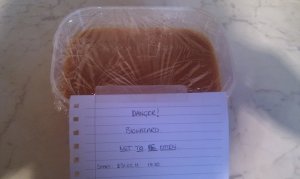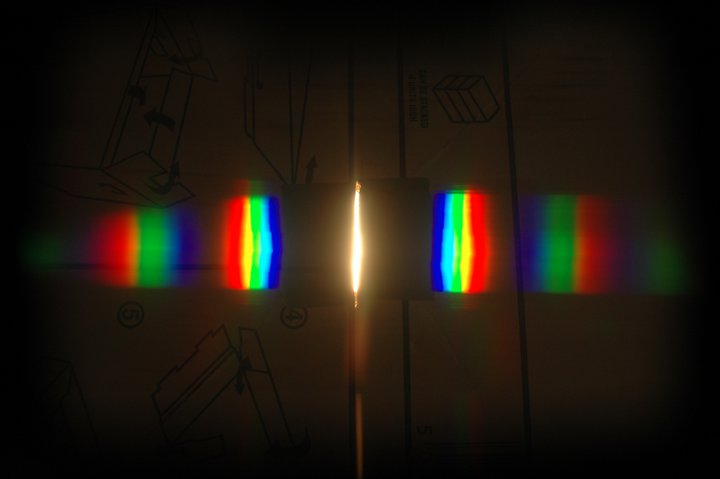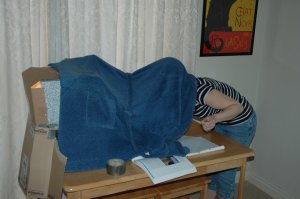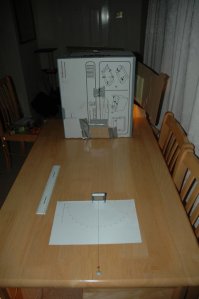TMA04
I must start this blog post with a bit of a "hurrah!" I have received my mark for TMA04 (Book 4: Chemistry). Drum roll... I got 92% - even with the "discussion" about one of the questions, and its ludicrous wording and requirements.
So, I'm very chuffed indeed. I understand chemistry. Or at least, I understand the basics, which will stand me in good stead for Book 5: Life - and, I hope, level two of my journey.
Mould
Activity 2.1 of Book 5 required me to investigate fungal particles in the air. In my kitchen, to be precise. So an experiment was undertaken. Bear with me... it's aces.
The aim of this investigation was to estimate the density of fungal particles (spores) in the kitchen by exposing an appropriate growth medium (Sainsbury's Basics tomato soup - I'm a cheapskate!) to a known volume of air, and then seeing how many fungi grow on it.
Equipment
Small can of Sainsbury's Basics tomato soup
Rectangular plastic container
Paper and sticky tape to label container
Cling film
Ruler.
Experimental design
The container needs to be wide enough and deep enough to accommodate the soup, plus a reasonable volume of air. About half a litre should be plenty. A rectangular container will make it easier to measure and calculate the volume of air under the cling film.
By washing the container thoroughly, and drying it upside down, the likelihood of contamination will be reduced. To ensure that nothing else gets inside, the soup will be transferred to the container quickly, and then immediately covered with clingfilm. A second layer of clingfilm will be used to make the container airtight, thus preventing anything else entering the container.
The volume of air can be measured by multiplying together the length and width of the container, and then multiplying by the depth of air from the clingfilm to the surface of the soup.
It should be kept out of reach of children and animals, and where it is unlikely to be disturbed. Although I can't imagine anyone - husband or cats - would look at that and think: "Ooh yum! I'm a bit peckish" and then dive right in...
How long should I leave it? Well, how long's a piece of string? That will depend on how quickly mould forms on the soup. A week or so should be fine.
I will record the start and finish date and time, and record when fungus first begins to appear, and when it stops increasing.
What should I do with the container and its contents afterwards? Well, the OU recommends that I throw away the whole shebang - for health and safety reasons (excuse me while I stop laughing); however, I will dispose of the mouldy soup in the toilet, rinse the container into the toilet, then put it through the dishwasher for a thorough wash. I am not throwing away a perfectly good Tupperware container! That's going to have my lunch in it tomorrow.
Practical procedure
The container was thoroughly washed and left upside down to dry. When it was dry, the can of soup was opened and quickly poured into the container. The soup was immediately
covered with two layers of clingfilm, and made airtight.
The experiment was labelled "Biohazard: not to be eaten", and the date and time recorded
(May 31, 2011 at 7.30pm). The container
was placed out of the reach of the cats, and left where it was unlikely to be disturbed.
The volume of air in the container was measured:
Depth from clingfilm to surface of soup: 3.0 cm
Width of container: 13.5 cm
Length of container: 18.5 cm
Volume = 3.0 cm x 13.5 cm x 18.5 cm
= 749.25 cm3
= 7.5 x 10-4 m3 (2 significant figures) Note: the corners of the container were rounded, so this figure is approximate.
The first mould began to appear on June 4 and were tiny white spots (about 1 mm in diameter), mostly around the edges of the tub.
On June 5, the white spots had grown to a diameter of around 3 mm to 4 mm, with 1 mm green/blue patches in places. More areas of growth had appeared. Condensation also appeared on the clingfilm, which made observations a little awkward.
My mould was respiring! I was so proud. My very own baby mould; they grow up so fast.
By June 9, no more spots were appearing. And it's probably a good thing, because it was getting a little crowded in there, and the patches were beginning to fight among themselves. I did NOT want to have to step in there and break anything up.
Results
Seventeen separate areas of mould were counted. Most of the mould was clinging to the edges of the soup on the container, with a few patches in the centre. The patches in the centre resembled blisters lying just on or beneath the surface. They were milky in appearance, and slightly jelly-like, measuring 0.5 cm to 1.0 cm in diameter. Delicious.
The patches around the edge were either white, or white with green/blue areas. The white patches had stalks, while the green/blue mould was furry in texture. These patches measured around 1.5 cm to 2.5 cm across. I've seen this furry mould before; it normally inhabits the bit of sandwich you've just put into your mouth. You know this, because there's half a patch of mould left when you look at your meal.
Analysis of results
Each area of growth probably represents one fungus, which arose from one fungal spore. My result was: 17 fungal spores per 7.5 x 10-4 m3 air.
To find the number of fungal spores per cubic metre of air:
= fungal spores per m3
= 2.3 x 104 fungal spores m-3 (2 significant figures)
I could work out the total number of fungal spores in the air in my whole kitchen; but frankly, I'd rather not know! I'm quite happily living in blissful ignorance, and perpetuating the dastardly rumour that I am, in fact, a great wife who cooks, cleans, maintains her rather great bottom AND makes interesting conversation that does not involve mould.
Critical thinking
The density of fungal spores I obtained is almost certainly an underestimate of the true density. This does not make me happy. I thought 22,666 spores per cubic metre was quite alarming enough.
Assumptions were made that the number of fungal spores in the air are evenly distributed throughout the room; this is unlikely to be the case, especially with movement of air. It may be that not all the spores trapped in the container grew into patches of mould. It was also assumed that all spores had grown into mould when I ended the experiment; this may not be the case.
Further investigations
We were supposed to think about what else we could investigate. But really, the only thing that came to mind was the mating habits of fungus. I suspect I've been staring at a screen for too long...
My next activity involves researching Leontopithecus rosalia. Stay tuned!





